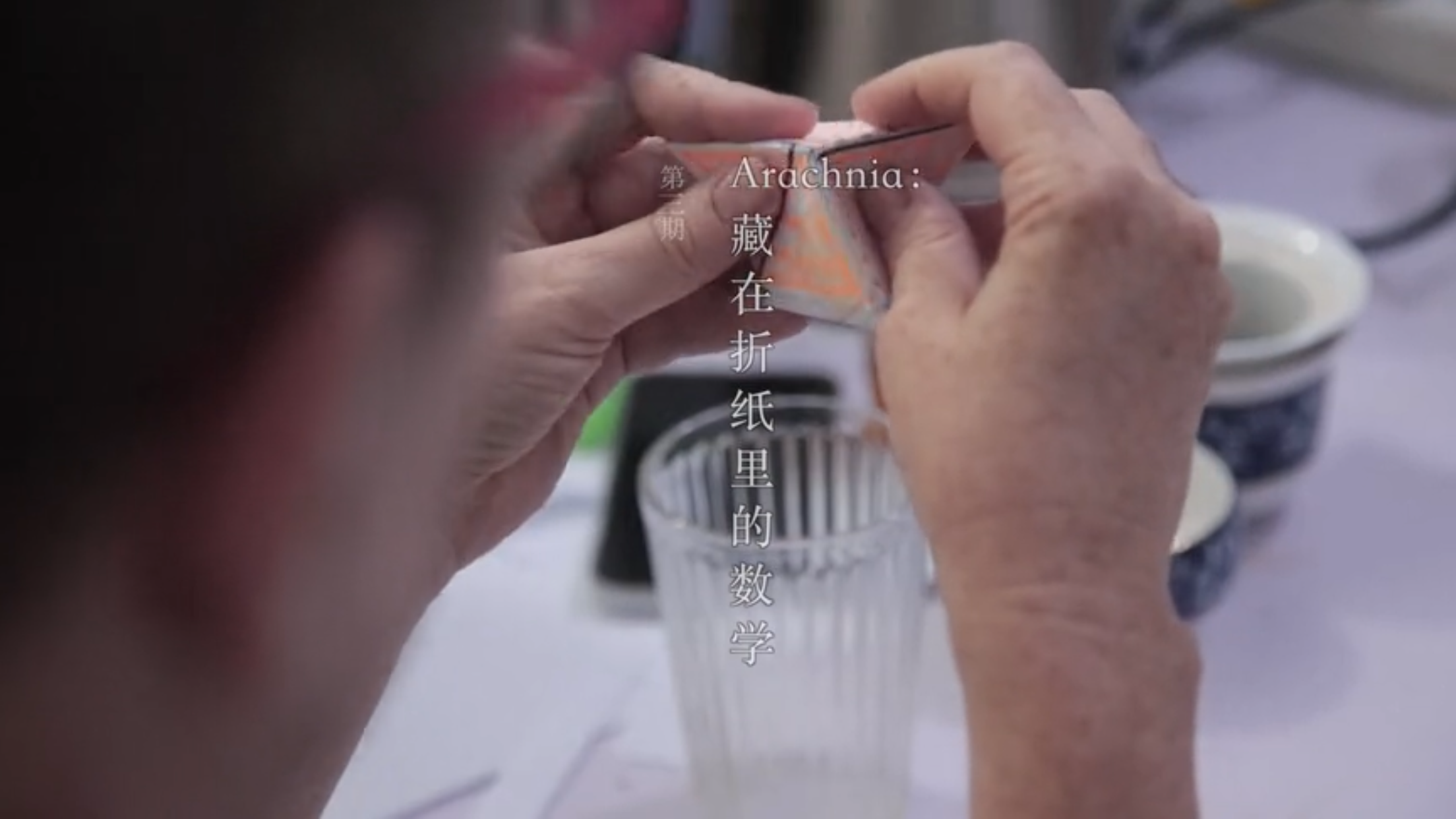This article was written by Mary Ann O’Donnell

Saturday, October 12, 2019, Rachel came to Handshake 302 to talk about how making taught her to love mathematics. Mary Ann and Kaiqin were particularly curious about what stimulates “math love,” they were even more surprised to discover that Wu Dan and Liu He were long-time math lovers! As you can imagine, many math secrets were revealed during the creative and fun and around wonderful “hexaflexagon” workshop.
2019年10月12日,Rachel来到握手302谈一谈“创客”是如何带她热爱上数学的。马立安和凯琴对什么能激发“数学之爱”特别好奇,她们更惊讶地发现吴丹和刘赫是长期的数学爱好者!可想而知,在这次精彩的“ 六角折变体(hexaflexagon)”工作坊中,握手302的小伙伴们不仅学到一些数学理论,还揭示了许多数学秘密!
During her self-introduction, Rachel revealed the first math secret of the day: it turns out that there’s a deep link between mathematicians and poets.
在自我介绍过程中,Rachel揭示了当今的第一个数学秘密,即:事实证明,数学家与诗人之间有着深远的心理联系。
INTP (I=introverted, N=iNtution, T=thinking, P=perception)
INTP (I = 内向的 [introverted], N = 直觉 [iNtution], T = 思考 [thinking], P = 感知 [perception])
According to the Myers Briggs personality test, INTPs thrive on understanding, exploring, mastering, and manipulating systems. In other words, INTPs love mathematics.
根据Myers Briggs的性格测验,有INTP心理的人对系统的了解、探索、掌握和操纵是无意识的行为。换句话说,INTP心理的人就是在数学发现人生的意义。
INFP (I=introverted, N=iNtution, F=feeling, P=perception)
INFP (I = 内向的 [introverted], N = 直觉 [iNtution], F = 感觉 [feeling], P = 感知 [perception])
Only one letter away from the INTPs are the INFPs—poets and idealists, who see the world through rose color glasses. But here’s the thing, there are some poets who fall in love with the beauty of mathematics, writing their sonnets to the universe in algorithms and number theory.
与INTP的距离只有一个字母的、有INFP心理的人是诗人和理想主义者,他们通过玫瑰色的眼镜看到世界。但问题是,当一名诗人爱上了数学的美时,她就会用算法和数论将自己的诗歌写给了宇宙。
The second math secret of the day: it turns out that we can learn mathematics from folding paper because we’re bored in math class! In fact, that’s how hexahexaflexagons were discovered.
当日的第二个数学秘密:事实证明,因为有人对数学课感到无聊,所以他才发现折叠纸法有数学意义!这就是Arthur H. Stone (斯通)发现六角折变体的原因。

The discovery of the first flexagon is credited to the British student Arthur H. Stone, who was studying at Princeton University in the United States in 1939. His new American paper would not fit in his English binder so he cut off the ends of the paper and began folding them into different shapes. One of these formed a trihexaflexagon. Stone’s colleagues Bryant Tuckerman, Richard Feynman, and John Tukey became interested in the idea and formed the Princeton Flexagon Committee.
1939年在美国普林斯顿大学,来自英国的斯通发现他买的美国纸张无法放入英国式的页夹中,因此他切掉了纸的末端,开始将它们折叠成不同的形状,就这样发现第一个六角折变体。斯通的同事布莱恩·塔克曼(Bryant Tuckerman),理查德·费曼(Richard Feynman)和约翰·图基(John Tukey)对这个想法产生了兴趣,并成立了“普林斯顿六角折变体小组”。
So where’s the math, you ask. In geometry, flexagons are flat models, usually constructed by folding strips of paper, that can be flexed or folded in certain ways to reveal faces besides the two that were originally on the back and front. Flexagons are usually square or rectangular (tetraflexagons) or hexagonal (hexaflexagons). A prefix can be added to the name to indicate the number of faces that the model can display, including the two faces (back and front) that are visible before flexing. For example, a hexaflexagon with a total of six faces is called a hexahexaflexagon.
那么,数学在哪里?在几何学中,折变体是平面模型,通常由折叠的纸条构成,可以以某些方式折叠,以显示除了最初在背面和正面上的两个面以外的其他面。折变体通常是正方形或六边形的,除了正方面还可以多藏着一、四等面,所谓“三面六角折变体”和“六面六角折变体”。
After the Princeton Flexagon Committee was formed, Tuckerman worked out a topological method, called the Tuckerman traverse, for revealing all the faces of a flexagon. Twenty years later, flexagons were introduced to the general public by Martin Gardner in the December 1956 issue of Scientific American in an article so well-received that it launched Gardner’s “Mathematical Games” column which then ran in that magazine for the next twenty-five years.
普林斯顿六角折变体小组成立后,塔克曼发明了一种称为“塔克曼导线”的拓扑方法,用于揭示折变体的所有面。二十年后,马丁·加德纳(Martin Gardner)在1956年12月出版的《科学美国人》上向公众介绍了折变体作为“数学游戏”。这种文章收到读者的好评,之后25年加德纳发表了更多的“数学游戏”。
The third and most important math secret of the day: making a hexaflexagon requires coming to terms with geometric theories of space. In turn, these theories can lead to new and wondrous understandings of the universe because in understanding to differentiate the ways to flex a flexagons, one could learn the similarity of the nuances in different quantum states. In fact, A high-order hexaflexagon was used as a plot element in Piers Anthony’s novel 0X, in which a flex was analogous to the travel between alternate universes.
当日的第三个,也可能是最重要的数学秘密,即:制作一个六面六角折变体需要每个小伙伴都对几何理论有所了解。接着,这些理论可以导致对宇宙的新颖而奇妙的理解,因为在理解制造六角折变体的方法时,我们也可以初步了解不同量子态中细微差别的相似性。实际上,在皮埃尔·安东尼(Piers Anthony)的小说《 0X》中,一个六角折变体的“折”被用来比喻宇宙之间的行程。
So, here are the patterns for making trihexaflexagons and hexahexaflexagons. Decorate your new toy any way you wish and then share your creative discoveries with a friend. And that sharing is, of course, the fourth math secret of the day: when you do math with friends it is so much more fun than when you do it alone!
在文章末尾我们开心地提供三面和六面六角折变体的折纸模型。随心所欲装饰你的新玩具,然后与朋友分享您的创意和发现。当然,分享是当日的第四个数学秘密,即:与朋友一起做数学比单独做题有趣得多!

